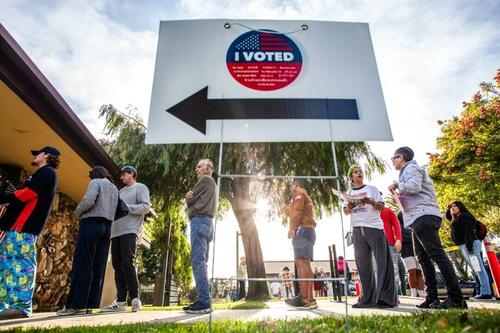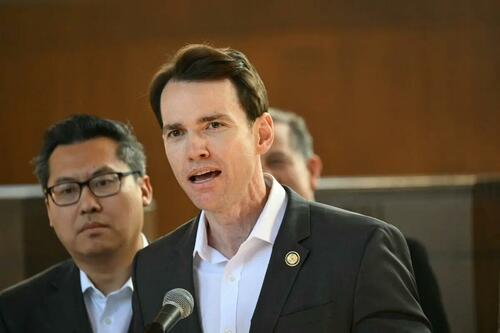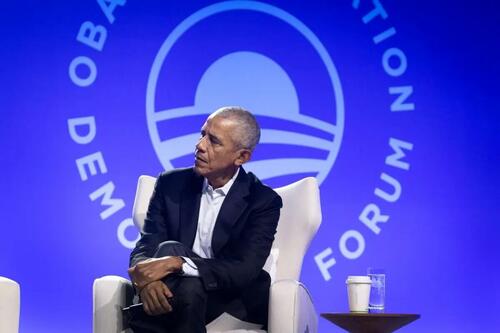What To Know About California’s Redistricting Ballot Measure
Authored by Joseph Lord via The Epoch Times,
On Nov. 4, Californians will go to the polls to vote in a referendum over whether to authorize replacing the state’s current congressional map with one designed to favor Democrats – a decision usually made by an independent commission.
California Gov. Gavin Newsom signed a bill on Aug. 21 to authorize the referendum. Democrats say the measure is meant to “fight fire with fire” after Texas moved forward with redistricting efforts to favor Republicans in the next election.
The California Legislature rushed the bill forward during a special session called by Newsom after Texas Gov. Greg Abbott convened the Texas Legislature to carry out its redistricting efforts.
Critics have condemned the Californian measure as unconstitutional, pointing to a current provision in the state’s Constitution that removes districting powers from the Legislature and governor.
Here’s what to know.
Bypasses Independent Districting Commission
California’s current congressional maps were adopted following the 2020 census. These maps, drawn by the politically neutral California Citizens Redistricting Commission, went into effect in 2022.
In a 2008 referendum, California voters approved a constitutional amendment that moved control of redistricting in the Golden State to the independent commission.
Democrats currently control 43 seats in the U.S. House delegation while Republicans hold nine.
Under the amendment, the California Legislature and governor are largely written out of the process of redistricting.
To get around that, voters will be asked to give their consent to approve the new maps that will last only for a limited time—dubbed Proposition 50 for the 50 U.S. states.
The maps voters are being asked to approve by Prop 50 would redraw the boundaries for five GOP-controlled districts, moving historically Democratic voters into the districts to increase Democrats’ chances of taking the seats.
How Long Will it Last
The changes to the map would last through the 2026, 2028, and 2030 election cycles.
At that point, following the 2030 census, control of the process would be returned to the Citizens Redistricting Commission, with new maps going into effect in 2032 and beyond.
The text of the ballot measure cites a goal to “neutralize” efforts by Republicans to redraw congressional maps in their party’s favor in Texas.
“It is the intent of the people that California’s temporary maps be designed to neutralize the partisan gerrymandering being threatened by Republican-led states without eroding fair representation for all communities,” it reads.
Five GOP Seats Threatened
While Republicans are already a minority in the Democrat-dominated state, they could lose as many as five more seats in the high-stakes 2026 midterms if the revised maps in California are approved.
Three California Republicans—Reps. Kevin Kiley, Doug LaMalfa, and Ken Calvert—are particularly endangered by the changes to the map, as their districts are on track to be inundated by voters who backed Vice President Kamala Harris in 2024.
Kiley, whose seat is most at risk of being flipped under the redrawn maps, has criticized both California and Texas for their redistricting efforts.
U.S. Rep. Kevin Kiley (R-Calif.) speaks during a press conference at Union Station in downtown Los Angeles on Feb. 20, 2025. Patrick T. Fallon/AFP via Getty Images
A bill introduced by Kiley would ban mid-decade redistricting entirely.
Two other GOP seats, currently held by Reps. Darrell Issa and David Valadao, will face tougher reelection bids under the redrawn maps but could still stay under GOP control, according to projections by The Cook Political Report.
It’s Up to Californian Voters
The 2008 amendment to the state’s Constitution has long been popular with voters, and Newsom and other California Democrats will need to campaign for the measure to push Prop 50 over the finish line.
A Politico/Citrin Center/Possibility Lab poll conducted between July 28 and Aug. 12 asked Californians whether they would “support keeping the independent redistricting commission” or “support returning congressional redistricting authority to state legislators.”
It found that 64 percent backed the independent commission, and only 36 percent backed giving authority to state legislators. California Democrats seemed resistant to Newsom’s referendum, with 61 percent still favoring the independent commission. However, when Democratic policy influencers were polled, they were split evenly between the independent commission and state legislators.
Republicans and Independents backed the independent commission by 66 and 72 percent, respectively.
However, the poll didn’t ask voters about the temporary change being proposed under Prop 50.
The text of the ballot measure emphasizes the temporary nature of the changes.
It says that the redrawn maps will “temporarily be used for every congressional election for a term of office commencing on or after the date this subdivision becomes operative and before the certification of new congressional boundary lines drawn by the Citizens Redistricting Commission.”
It also emphasizes that the Citizens Redistricting Commission “shall continue to adjust the boundary lines” of federal and state-level districts “in 2031, and every 10 years thereafter.”
A more recent poll by UC Berkeley IGS found more favorable signs for Democrats. It found that 48 percent of voters approve of the new map and 32 percent oppose the redistricting effort, with 20 percent undecided.
A Politico/Citron poll found that nationally, 63 percent of Democrats supported California’s redistricting effort, 18 percent supported the independent commission, and 19 percent were undecided.
Reactions
In both California and nationally, the redistricting efforts have drawn mixed reactions.
Former President Barack Obama expressed support for Newsom’s move.
“I believe that Gov. Newsom’s approach is a responsible approach. He said this is going to be responsible. We’re not going to try to completely maximize it,” he said at an Aug. 19 fundraiser on Martha’s Vineyard in Massachusetts.
“We’re only going to do it if and when Texas and/or other Republican states begin to pull these maneuvers. Otherwise, this doesn’t go into effect.”
Former President Barack Obama at the Obama Foundation’s 2024 Democracy Forum on Dec. 5, 2024 in Chicago, Illinois. Scott Olson/Getty Images
In an interview with California Capitol journalist Eytan Wallace, state Assemblyman Carl DeMaio, a Republican from San Diego, described the push as a “corrupt, illegitimate, and illegal effort by politicians to remove citizens from [the process of] drawing the lines and [give] the power back to politicians.”
DeMaio also criticized the Republicans’ bid to increase their hold on the Texas House delegation, saying, “Gerrymandering is wrong no matter who’s doing it, whether it’s done by a red state or a blue state.”
“We want the citizens to be able to draw the lines, not the politicians,” he said.
The National Republican Congressional Committee, the House GOP’s main campaign arm, also accused Newsom of violating the California Constitution.
“Newsom’s made it clear: He’ll shred California’s Constitution and trample over democracy—running a cynical, self-serving playbook where Californians are an afterthought and power is the only priority,” Christian Martinez, a spokesperson for the group, said in a statement.
Tyler Durden
Mon, 08/25/2025 – 15:00ZeroHedge NewsRead More







 T1
T1


